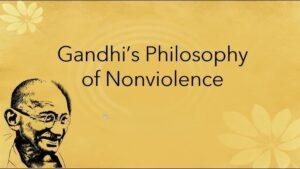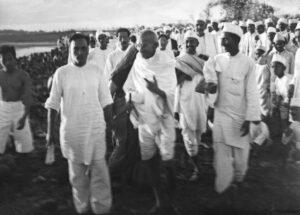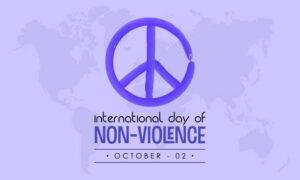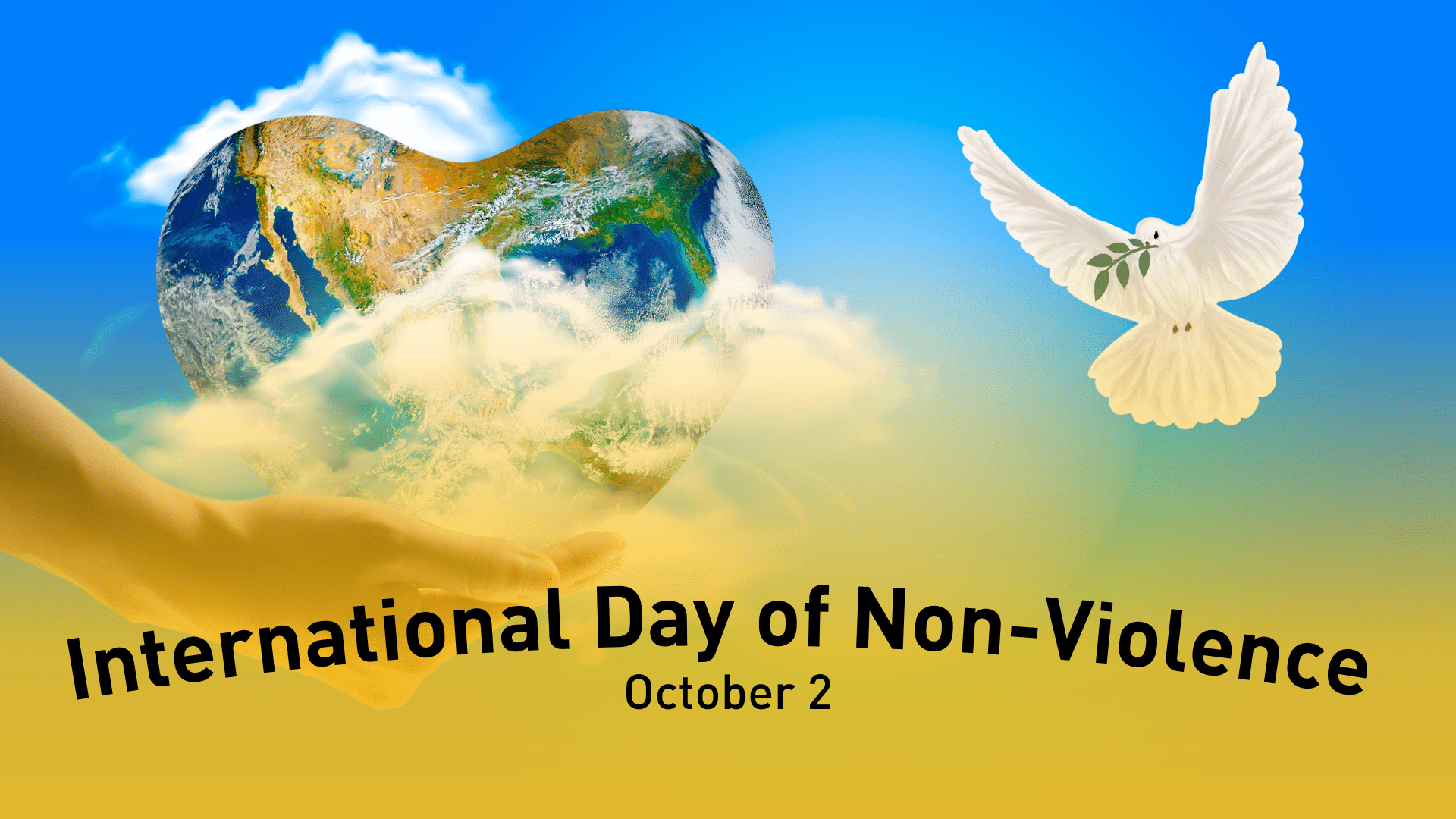Why International Day of Non Violence is Celebrated On 2nd Oct Every Year?

The International Day of Non Violence, observed annually on October 2, stands as a symbol of humanity’s long-standing quest for peace and justice. This day not only commemorates the birthday of Mahatma Gandhi, the leader of India’s non-violent independence movement but also serves as a reminder of the universal relevance of non-violence in addressing conflicts, fostering reconciliation, and promoting human rights across the globe.
As the world grapples with various forms of violence—ranging from armed conflicts to domestic violence, social injustice, and environmental degradation—this day offers an opportunity to reflect on the principles of non-violence and their enduring relevance in contemporary society. This post delves deep into the origin, significance, and importance of non-violence, explores historical figures and movements that have embraced it, and examines how individuals, organizations, and governments can adopt and promote non-violent principles for lasting peace and justice.
-
The Origins of the International Day of Non Violence

1.1 Mahatma Gandhi: The Champion of Non Violence
The International Day of Non Violence was established in 2007 by the United Nations General Assembly, a significant step to honor Mahatma Gandhi, born on October 2, 1869. Mohandas Karamchand Gandhi, affectionately called Bapu (Father), became the face of non-violent resistance through his concept of Satyagraha (truth-force) during India’s fight for independence against British colonial rule.
Also See- Why United Nations Considers Gandhi Jayanti As International Day Of Non Violence
Gandhi’s method of non-violent resistance involved peaceful protests, civil disobedience, and a firm commitment to Ahimsa, a principle of non-harm toward all living beings. His belief in the power of non-violence reshaped global conversations on how oppressed societies could assert their rights without resorting to violence.
1.2 The Birth of a Global Day for peace
The proposal for the International Day of Non Violence was put forward by India at the United Nations in 2007, underscoring the global relevance of Gandhi’s ideals. The resolution not only honors Gandhi’s legacy but also seeks to “disseminate the message of non-violence, including through education and public awareness.” It was widely embraced by member states, making it a truly global initiative.
While Gandhi’s principles were born in a specific historical context, the resonance of non-violence as a tool for change extends far beyond his era and geography. Non-violent movements have shaped modern history and continue to inspire individuals and groups seeking justice and equality around the world.
-
The Concept of Non-Violence: Philosophical and Ethical Foundations

2.1 Defining Non-Violence
Non-violence, in its simplest form, is the practice of refraining from violence in one’s actions, thoughts, and words. More than the mere absence of physical aggression, non-violence encompasses a broader commitment to compassion, empathy, and respect for all living beings. It is not passive but rather an active stance against injustice.
The philosophical underpinnings of non-violence can be traced to various spiritual and ethical traditions, from Hinduism and Buddhism to Jainism and Christianity. The principle of Ahimsa, or non-harm, is central to these belief systems, urging adherents to live in a way that minimizes harm to others, whether human or non-human.
2.2 Non-Violence as a Political Strategy
As a political strategy, non-violence has been employed by oppressed and marginalized groups throughout history to challenge unjust systems of power. Unlike violent revolutions, non-violent resistance seeks to bring about change without the loss of life or the perpetuation of a cycle of violence. It aims to convert the oppressor through moral persuasion, appealing to their conscience and sense of justice.
Gandhi’s Satyagraha is the most famous example of this approach, but it has also been used by civil rights leaders like Martin Luther King Jr. and Nelson Mandela. These movements demonstrated that non-violence could be a powerful tool for achieving social change, often yielding more lasting results than violent uprisings.
2.3 Non Violence in Religion and Philosophy
- Non violence is not exclusive to political struggles. Many religious traditions view non-violence as a way of life. In Jainism, for example, Ahimsa is the central tenet. Jains believe that all living beings have souls, and harming another being is equivalent to harming oneself.
- In Buddhism, the principle of non-violence is closely related to compassion and the desire to alleviate the suffering of others. The Buddha taught that violence only begets more violence, leading to an endless cycle of suffering.
- In Christianity, Jesus’ teachings emphasized love, forgiveness, and turning the other cheek, all of which align with non-violent principles. Tolstoy, influenced by Christian teachings, wrote extensively about non-violence, and his works greatly inspired Gandhi.
-
Historical Movements of Non-Violence: Learning from the Past

3.1 The Indian Independence Movement
India’s struggle for independence from British rule is one of the most notable examples of a successful non-violent movement. Under Gandhi’s leadership, millions of Indians participated in protests, boycotts, and civil disobedience campaigns, refusing to cooperate with the colonial government.
The Salt March of 1930 is one of the most iconic events in this movement. Gandhi led a 240-mile march to the Arabian Sea to produce salt, defying British laws that taxed Indian salt production. This act of civil disobedience drew international attention to the injustice of British rule and galvanized Indian support for the independence movement.
Despite facing brutal repression from the British authorities, Gandhi remained steadfast in his commitment to non-violence. His strategy of non-violent resistance ultimately played a key role in India achieving independence in 1947.
3.2 The American Civil Rights Movement
In the 1950s and 1960s, African Americans in the United States fought against racial segregation and discrimination through a non-violent civil rights movement. Inspired by Gandhi’s example, Martin Luther King Jr. adopted the principles of non violence as the foundation of his activism.
The Montgomery Bus Boycott of 1955-1956, triggered by Rosa Parks’ refusal to give up her seat to a white person, was one of the first major non-violent protests of the movement. For over a year, African Americans in Montgomery, Alabama, refused to use the city’s buses, crippling the bus system and forcing the city to desegregate its public transportation.
The movement’s success was further demonstrated in the March on Washington for Jobs and Freedom in 1963, where King delivered his famous “I Have a Dream” speech. This movement, grounded in non-violent protest, played a significant role in the passage of the Civil Rights Act of 1964 and the Voting Rights Act of 1965, marking a major victory in the fight for racial equality in the United States.
3.3 The Anti-Apartheid Movement in South Africa
Nelson Mandela’s fight against apartheid in South Africa also drew heavily on non-violent principles, although the movement evolved to include armed struggle when peaceful efforts were met with extreme state violence. Mandela spent 27 years in prison for his role in opposing the apartheid regime, but his vision for a non-racial, democratic South Africa remained rooted in the hope of reconciliation rather than revenge.
The anti-apartheid movement was not just a local affair but gained international support. The global boycott of South African goods, along with protests and advocacy, put pressure on the apartheid regime, eventually leading to its collapse in the early 1990s. Mandela’s eventual presidency symbolized the triumph of non-violent ideals over the brutality of apartheid.
3.4 The Peace Movement and Anti-War Protests
The 20th century also witnessed numerous non-violent movements aimed at ending wars and preventing violence between nations. The Peace Movement gained prominence during the Vietnam War, with millions of people across the world protesting against what they saw as an unjust and unnecessary conflict.
Anti-war protests in the United States, particularly during the 1960s and 1970s, showcased how non-violent resistance could influence public opinion and government policy. Protests, sit-ins, and draft resistance actions helped to shift the national discourse and eventually contributed to the end of the Vietnam War.
The global peace movement continues to thrive, with numerous organizations working to promote diplomacy, disarmament, and peaceful resolutions to conflicts. These movements highlight the ongoing relevance of non violence in international relations.
-
The Enduring Significance of Non Violence in the Modern World

4.1 Non-Violence in the Face of Modern Conflicts
In the 21st century, non-violence continues to be a vital tool in addressing conflicts around the world. Whether it is the ongoing Israeli-Palestinian conflict, the struggles for democracy in Myanmar, or the protests against authoritarianism in places like Belarus and Hong Kong, non-violent movements play a critical role in seeking justice and equality.
While many of these movements face brutal crackdowns by oppressive regimes, they also demonstrate the power of peaceful resistance in rallying international support and highlighting the moral failings of violent repression. Non-violent protestors, often armed with nothing more than placards, social media, and the strength of their convictions, remind the world that violence does not need to be met with violence.
4.2 Non-Violence in Social Movements
Beyond geopolitical conflicts, non-violence is also essential in the realm of social justice movements. Issues like climate change, gender equality, and economic justice are increasingly being tackled through non-violent activism.
The Fridays for Future movement, led by Greta Thunberg, is one example of how non-violent action can draw attention to critical global issues like climate change. The youth-led climate strikes have mobilized millions of people worldwide, demonstrating the power of peaceful protest in driving change.
Similarly, movements like #MeToo and Black Lives Matter have used non-violent means to challenge deeply entrenched systems of discrimination and oppression. Through protests, social media campaigns, and public demonstrations, these movements have forced society to confront issues of racial and gender-based violence.
4.3 Non Violence as a Path to Reconciliation
One of the most profound aspects of non-violence is its potential to foster reconciliation. In many post-conflict societies, non-violent approaches to justice and reconciliation have been key to healing the wounds of war and division.
The Truth and Reconciliation Commission in South Africa is an example of how non-violent approaches to justice can help a society move forward after years of violence and oppression. By focusing on truth-telling and forgiveness rather than retribution, South Africa was able to avoid a cycle of revenge and build a new democratic nation.
Similarly, the peace processes in places like Northern Ireland and Rwanda have demonstrated the importance of non-violent dialogue and reconciliation in overcoming the legacies of conflict.
4.4 Non-Violence and the Role of the United Nations
The United Nations has played a central role in promoting non-violence on a global scale. Through peacekeeping missions, diplomacy, and advocacy for human rights, the UN works to prevent conflicts and foster non-violent solutions to global challenges.
The International Day of Non Violence is just one example of the UN’s commitment to these principles. By encouraging education and public awareness about non-violence, the UN hopes to inspire individuals and governments to adopt non-violent methods in addressing conflicts and challenges.
4.5 Non-Violence in Environmental Movements
The environmental crises facing the world today, such as climate change, deforestation, and pollution, are prompting global movements that embrace non-violence as a core principle. Peaceful protests, legal challenges, and public advocacy are at the forefront of efforts to hold governments and corporations accountable for environmental destruction.
Movements like Extinction Rebellion and Greenpeace have long used non-violent tactics to raise awareness about environmental issues and push for policy changes. By blocking infrastructure projects that contribute to environmental harm or organizing global climate strikes, these groups emphasize the need for urgent action through peaceful means.
-
Promoting Non Violence in the 21st Century

5.1 Education for Non Violence is must
One of the key ways to promote non-violence in today’s world is through education. Schools, universities, and organizations must integrate lessons on non violence, empathy, and conflict resolution into their curricula. By teaching young people about the power of peaceful resistance and the ethical foundations of non violence, we can cultivate a new generation of leaders who prioritize dialogue over conflict.
Peace education programs, such as those supported by UNESCO, aim to equip individuals with the skills needed to resolve conflicts without violence. These programs teach the importance of understanding different perspectives, practicing empathy, and using communication and negotiation to address disagreements.
5.2 The Role of Technology and Social Media
In today’s digital age, technology and social media offer powerful tools for promoting non violence. Platforms like Twitter, Instagram, and Facebook allow activists to organize protests, share their message with a global audience, and hold authorities accountable for their actions.
The Arab Spring of 2010-2011, for example, demonstrated how social media could be used to mobilize non-violent protests and spread messages of resistance. While these platforms have also been used to incite violence, they hold great potential for spreading non-violent messages and organizing peaceful movements.
However, the rise of disinformation and hate speech on these platforms also poses a challenge to non-violent activism. It is essential for activists and platforms alike to work together to ensure that social media remains a space for constructive dialogue and peaceful organizing.
5.3 Building Alliances and Global Movements
Non violence is most effective when it is part of a broader movement that brings together diverse groups and individuals committed to the same cause. Building coalitions and alliances across racial, ethnic, gender, and national lines can amplify the impact of non-violent movements and create a united front against oppression and violence.
International organizations, NGOs, and civil society groups have a crucial role to play in supporting non-violent movements. By providing resources, training, and platforms for non-violent activists, these organizations can help build the capacity of movements to achieve their goals without resorting to violence.
5.4 Governments and Non Violence: Policy Recommendations
Governments have a responsibility to promote and uphold non-violence both domestically and internationally. This can be done through several key policy measures:
- Investing in education and public awareness: Governments should support educational programs that teach conflict resolution, human rights, and the principles of non violence.
- Supporting diplomacy and dialogue: In international relations, governments should prioritize diplomacy and peaceful negotiation over military intervention.
- Protecting the right to protest: Governments must ensure that citizens have the right to engage in peaceful protest without fear of violence or repression.
- Disarming and promoting demilitarization: Governments should work toward reducing their reliance on military force and investing in peacebuilding initiatives instead.
5.5 Individual Action: What You Can Do
While governments and organizations play a significant role in promoting non-violence, individuals also have a crucial part to play. Each person can contribute to a more peaceful world through their actions and choices.
- Practice non violence in everyday life: This can mean resolving conflicts with empathy and understanding, refusing to engage in harmful behavior, and promoting kindness and compassion in personal relationships.
- Get involved in social justice movements: Support non-violent movements and organizations that work for peace, justice, and equality.
- Advocate for non violence in your community: Organize or participate in events that promote non-violence, such as peace marches, public discussions, and educational workshops.
- Use your voice: Whether through writing, art, social media, or public speaking, use your platform to advocate for non-violent solutions to the world’s problems.
Final Conclusion on International Non Violence Day

The International Day of Non Violence is more than just a day of reflection—it is a call to action. In a world rife with conflict, injustice, and suffering, the principles of non-violence offer a pathway to lasting peace and justice. By embracing non-violence in our personal lives, supporting non-violent movements, and advocating for peaceful solutions to global problems, we can help build a world where compassion, empathy, and understanding prevail over hatred and division.
As we commemorate this day, let us remember that the power of non-violence lies not in passivity but in its capacity to transform individuals, communities, and nations. It is a force for good that has changed the course of history and continues to shape a better future for all.
Follow Us On Facebook & Instagram For More.

[…] Must See: Why International Non Violence Day Celebrated on 2nd Oct Every Year […]
[…] Also See– International Day Of Non Violence 2024- Our Global Call For Peace […]